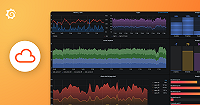Important: This documentation is about an older version. It's relevant only to the release noted, many of the features and functions have been updated or replaced. Please view the current version.
Go (push mode)
Pyroscope uses the standard runtime/pprof package to collect profiling data. Refer to
the official documentation for details.
How to add Golang profiling to your application
To start profiling a Go application, you need to include our go module in your app:
go get github.com/grafana/pyroscope-goNote: If you’d prefer to use Pull mode you can do so using the Grafana Agent.
Then add the following code to your application:
package main
import "github.com/grafana/pyroscope-go"
func main() {
// These 2 lines are only required if you're using mutex or block profiling
// Read the explanation below for how to set these rates:
runtime.SetMutexProfileFraction(5)
runtime.SetBlockProfileRate(5)
pyroscope.Start(pyroscope.Config{
ApplicationName: "simple.golang.app",
// replace this with the address of pyroscope server
ServerAddress: "http://pyroscope-server:4040",
// you can disable logging by setting this to nil
Logger: pyroscope.StandardLogger,
// you can provide static tags via a map:
Tags: map[string]string{"hostname": os.Getenv("HOSTNAME")},
ProfileTypes: []pyroscope.ProfileType{
// these profile types are enabled by default:
pyroscope.ProfileCPU,
pyroscope.ProfileAllocObjects,
pyroscope.ProfileAllocSpace,
pyroscope.ProfileInuseObjects,
pyroscope.ProfileInuseSpace,
// these profile types are optional:
pyroscope.ProfileGoroutines,
pyroscope.ProfileMutexCount,
pyroscope.ProfileMutexDuration,
pyroscope.ProfileBlockCount,
pyroscope.ProfileBlockDuration,
},
})
// your code goes here
}How to add profiling labels to Golang applications
It is possible to add tags (labels) to the profiling data. These tags can be used to filter the data in the UI. We have a custom API that’s in line with the go-native pprof api:
// these two ways of adding tags are equivalent:
pyroscope.TagWrapper(context.Background(), pyroscope.Labels("controller", "slow_controller"), func(c context.Context) {
slowCode()
})
pprof.Do(context.Background(), pprof.Labels("controller", "slow_controller"), func(c context.Context) {
slowCode()
})Mutex Profiling
Mutex profiling is useful for finding sources of contention within your application. It helps you to find out which mutexes are being held by which goroutines.
To enable mutex profiling, you need to add the following code to your application:
runtime.SetMutexProfileFraction(rate)rate parameter controls the fraction of mutex contention events that are reported in the mutex profile. On average 1/rate events are reported.
Block Profiling
Block profiling lets you analyze how much time your program spends waiting on the blocking operations such as:
- select
- channel send/receive
- semacquire
- notifyListWait
To enable block profiling, you need to add the following code to your application:
runtime.SetBlockProfileRate(rate)rate parameter controls the fraction of goroutine blocking events that are reported in the blocking profile. The profiler aims to sample an average of one blocking event per rate nanoseconds spent blocked.
Sending data to Pyroscope OSS or Grafana Cloud Profiles using Golang SDK
pyroscope.Start(pyroscope.Config{
ApplicationName: "example.golang.app",
ServerAddress: "<URL>",
// Optional HTTP Basic authentication
BasicAuthUser: "<User>",
BasicAuthPassword: "<Password>",
// Optional Pyroscope tenant ID (only needed if using multi-tenancy). Not needed for Grafana Cloud.
// TenantID: "<TenantID>",
ProfileTypes: []pyroscope.ProfileType{
pyroscope.ProfileCPU,
pyroscope.ProfileInuseObjects,
pyroscope.ProfileAllocObjects,
pyroscope.ProfileInuseSpace,
pyroscope.ProfileAllocSpace,
},
})To configure the Golang SDK to send data to Pyroscope, replace the <URL> placeholder with the appropriate server URL. This could be the Grafana Cloud URL or your own custom Pyroscope server URL.
If you need to send data to Grafana Cloud, you’ll have to configure HTTP Basic authentication. Replace <User> with your Grafana Cloud stack user and <Password> with your Grafana Cloud API key.
If your Pyroscope server has multi-tenancy enabled, you’ll need to configure a tenant ID. Replace <TenantID> with your Pyroscope tenant ID.
Golang profiling examples
Check out the following resources to learn more about Golang profiling:
- Golang examples
- Golang Demo showing golang example with tags
- Golang blog post
Was this page helpful?
Related documentation
Related resources from Grafana Labs



